Why Doesnew York Review Instant Replays in Football
History of Instant Replay
Upon farther review…
The NFL's instant replay debate has been a hot-button topic since games were get-go regularly televised in the late 1940s. Traditionalists, hesitant to interfere with the purity of the game by removing human error, clashed with those eager to embrace technology and all that it offered the game.
The NFL has come to comprehend instant replay, only the process that led to the land-of-the-art organisation the league uses today was not always seamless. The history of instant replay in professional person football is filled with stops and starts; missteps and controversy; and modifications and improvements that keep to this 24-hour interval.
Instant replay's history begins in earnest four decades ago — with a man and a stopwatch.
STOPWATCHES AND VIDEO CAMERAS
The NFL kickoff experimented with instant replay in 1976 when Art McNally, then the director of officiating, wanted to find out how long a video review would delay a game. Equipped with a stopwatch and video camera, he observed a "Monday Dark Football" contest betwixt the Dallas Cowboys and Buffalo Bills from a press box within the stadium.
"If there was whatever question, nosotros took a look at it," McNally said after the experiment. "Nosotros asked the camera technicians to requite us different angles."
He saw a missed phone call on a play involving O.J. Simpson that could have been corrected with replay review. McNally knew then: Replay could help football.

The NFL tested instant replay during the 1978 Hall of Fame game and six other preseason games that year. It adamant the organisation was not yet ready for regular-season games. (AP Photo/Rusty Kennedy)
Two years after, the league first tested instant replay on a wider scale during vii nationally televised preseason games, starting with the 1978 Hall of Fame game betwixt the Philadelphia Eagles and Miami Dolphins.
The system's operation was lackluster. The applied science was too costly to install at every stadium, the organization needed more than cameras than broadcasters used for games at the time, and calls remained inconclusive after lengthy reviews. Information technology was clear instant replay was years away from being implemented full time.
"Nosotros still think we need a minimum of 12 cameras to get all the angles on every play," so-banana supervisor of officials Nick Skorich said after that kickoff game. "Electronically, I don't know if we are advanced enough yet."
Unwilling to implement a costly and ineffective system, the league shelved instant replay until the mid-1980s.
INITIAL INSTANT REPLAY: 1985–1992
Less than a decade afterwards McNally's experiment, momentum for an instant replay system once again began to build.
The NFL tested a review system during 8 preseason games in 1985 — producing promising results.
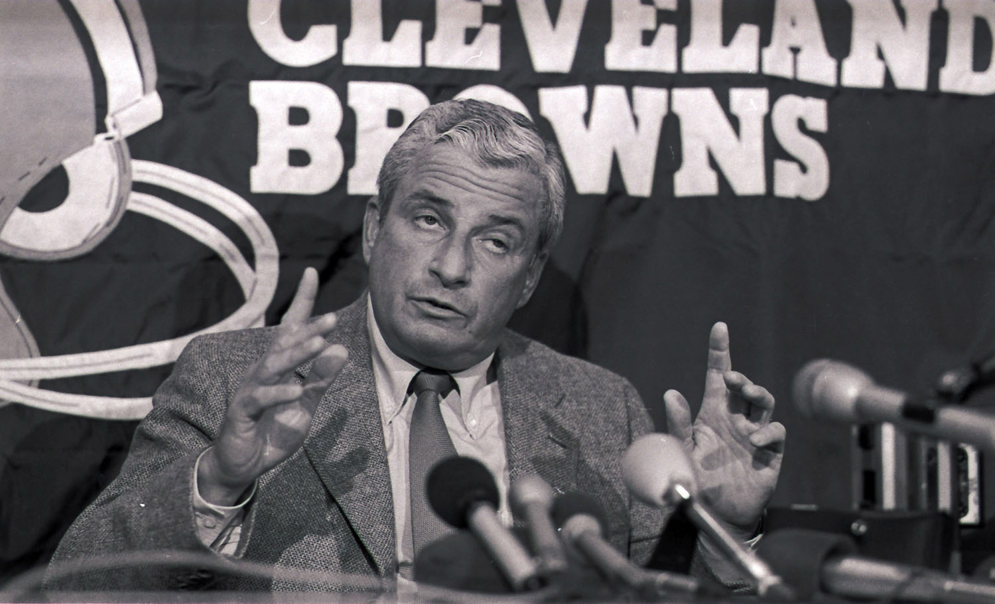
Cleveland Browns possessor Art Modell delivers a bulletin during a 1982 news conference. (AP Photo/Mark Duncan)
"The thing nosotros learned in the preseason is that nosotros can get the logistical things done," NFL Director of Administration Joe Rhein said. "That is, it'due south possible to review instant replays [in the press box] and get the word to the referee on the field without a meaning loss of fourth dimension."
The organisation performed so well that owners held an unprecedented vote to determine if the league would use instant replay in the upcoming playoffs — even though the organization had never been used in the regular season. The motion failed narrowly, only the close decision made information technology clear the league's leaders were once again warming upward to the technology.
"[Owners] didn't want a playoff game decided past a bad call, and and then they tried to push it through right there," Fine art Modell, Cleveland Browns owner, said afterwards the vote. "But that was a petty also quick for some people."
"Some clubs may take voted against information technology at the time because it was adding something for the postseason that was not available during the regular season," NFL spokesman Joe Browne said at the time.
In the proposed 1985 arrangement, a replay official would have monitored the game feed from an in-stadium booth and initiated all reviews, reversing a call only with "indisputable visual evidence."
Prior to the 1986 season, the owners voted 23-iv-1 — 21 votes were needed to pass — to adopt limited utilise of instant replay in the upcoming year. The initial process lacked the coach's challenges and technology familiar to today's fans. Most reviews were initiated upstairs past the replay official, except when game officials requested a review of their ruling after conferring on the field.
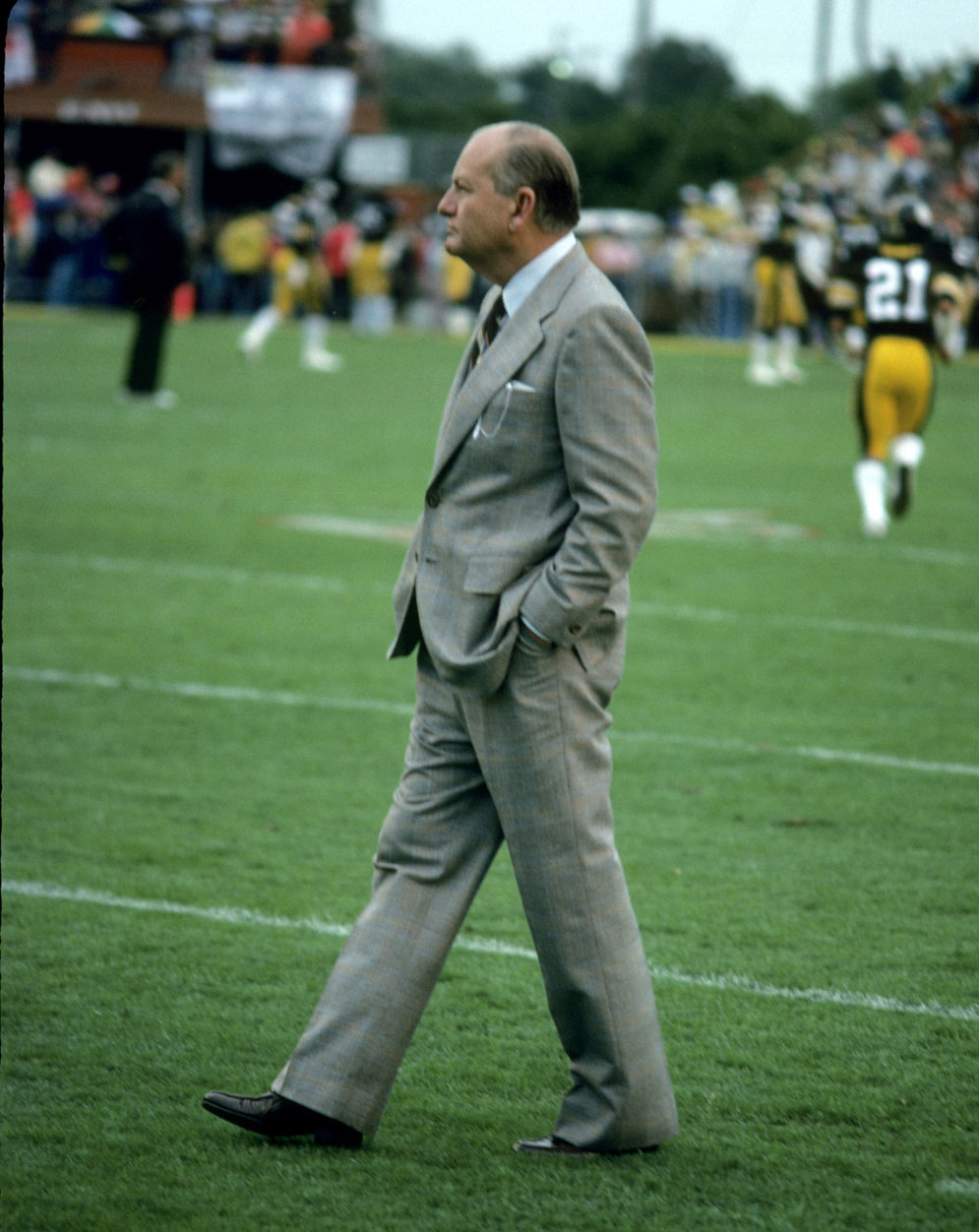
Dallas Cowboys president and general manager Tex Schramm stalks the sidelines before Super Bowl XIII, a 35-31 loss to the Pittsburgh Steelers on Jan. 21, 1979. (AP Photograph/NFL Photos)
Reviewable plays during instant replay'southward starting time installation included:
- Plays of possession or touching (fumbles, interceptions, receptions, muffs, or ineligible player touching a forward pass);
- Most plays governed by the sidelines, goal lines, stop lines and line of scrimmage (whether a player is out of bounds, forrad or astern passes or breaking the plane of the goal line);
- And easily detectable infractions on replay (too many men on the field).
The conclusion was only reached afterwards a spirited argue and concessions to appease skeptics. The compromise: The organisation would exist guaranteed for simply one year and would have to exist voted on again during the post-obit offseason.
"Some feel we are taking the homo chemical element out of the game and moving it to a booth in the printing box," said Tex Schramm, who then served as Dallas Cowboys general manager and NFL Competition Commission chairman.
Replay officials sabbatum in a booth in the stadium with ii 9-inch idiot box monitors showing the circulate feed and two videocassette recorders. The two VCRs were capable of recording and immediately replaying individual plays. Reviews would be a maximum of ii minutes, timed from the moment when the umpire signaled timeout.
First apply of instant replay in 1986 Week 1 betwixt the Browns and Bears.
Instant replay'southward first regular flavour saw an average of ane.vi reviews per game. Of those plays in question — 374 in all — only ten per centum ended with a reversal of the ruling on the field.
The owners reapproved instant replay for the next flavor. Barely. The mensurate got exactly the 21 votes needed to pass (21-7) and was accepted with a few pocket-size tweaks. But just like the 1986 decision, the system would accept to exist approved again the following offseason.
Some adjustments were made in an attempt to improve the system. To ensure replay officials were experts on the technology, the NFL would at present hold a preparation clinic each offseason. The equipment improved as well, albeit slightly, as review monitors were upgraded — from nine inches to 12 inches.
"I'm confident the system will go improve and better," Hall of Fame Miami Dolphins coach Don Shula said afterwards the '87 vote. "As coaches, nosotros realized we can't meet a game from the sidelines as well every bit our coaches can from upstairs in the press box. If you transmit that same thinking to officials, it helps them likewise."
BUMPS IN THE Route
The beginning system did non lack controversies — or critics.
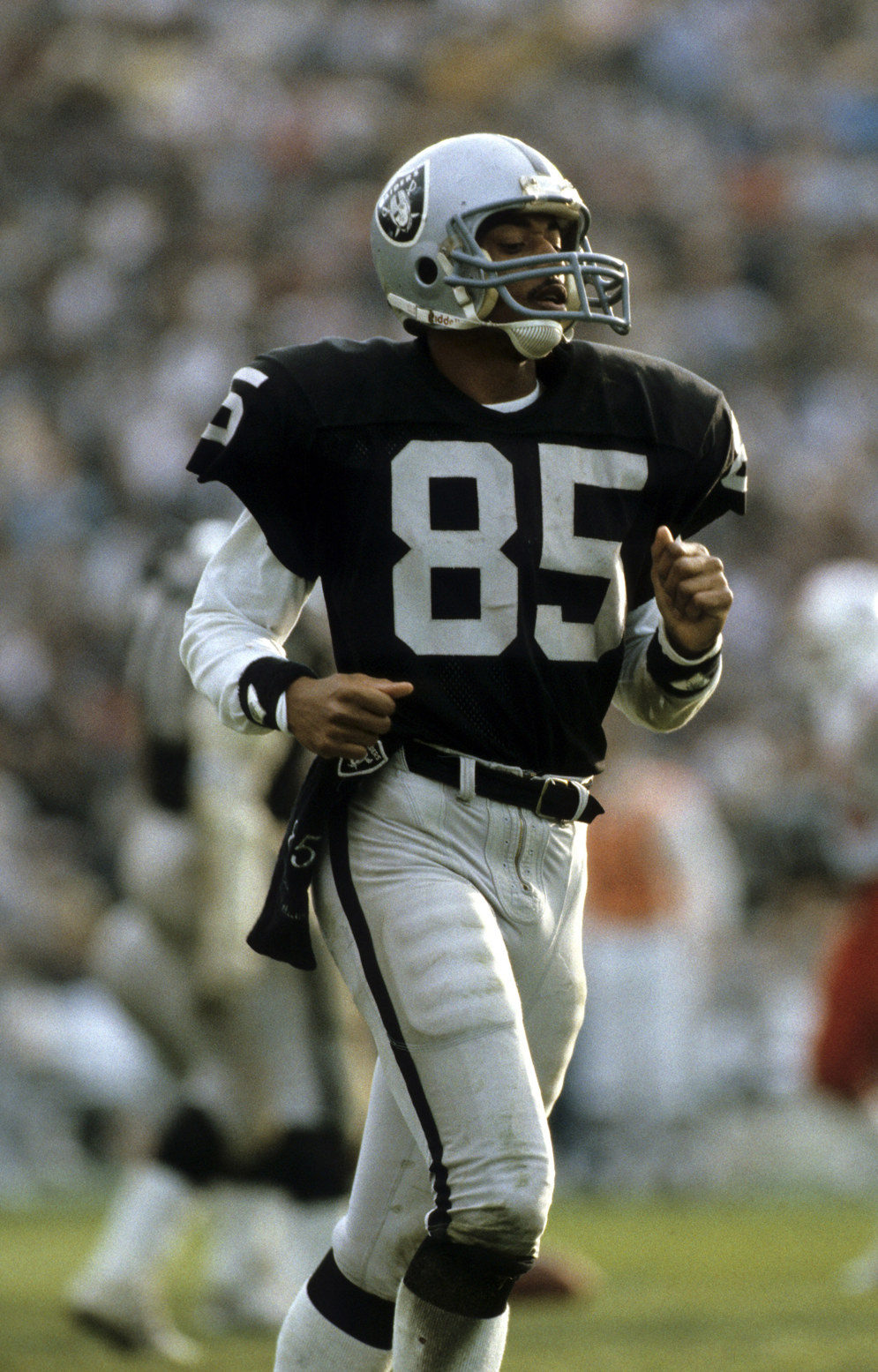
A miscommunicated instant replay call in October 1986 awarded Oakland Raiders receiver Dokie Williams a touchdown on a play that should accept been ruled an incomplete pass. (AP Photo/NFL Photos)
During a Kansas City Chiefs and Oakland Raiders game in October 1986, Raiders quarterback Marc Wilson threw a laissez passer to Dokie Williams in the corner of the terminate zone late in the commencement half. The on-field officials ruled the play a touchdown. Merely up in the instant replay booth Jack Reader, assistant supervisor of officials, determined it was incomplete.
"Pass incomplete," Reader told umpire John Keck with the walkie-talkies used for instant replay system communication.
"Pass is consummate," Keck heard. Inadvertently, the touchdown stood. The Raiders won past a touchdown — 24-17.
"My buddy, the instant replay guy," Williams jokingly said later on the game.
But the miscommunication was no laughing matter to the NFL. The league replaced its walkie-talkies with pagers and radio headsets and it changed the terminology, using clearer terms like "confirmed" and "reversed."
NFL Commissioner Paul Tagliabue, long a proponent of instant replay, was eager to improve the system.
"I'm hopeful we tin can make some modifications and keep the concept and make information technology piece of work rather than step back out of the electronic age," he said in 1990.
The commissioner'due south hopes were dashed. Afterwards a six-season run, instant replay met its demise in 1991 when 17 owners voted confronting renewing the system. The conventionalities: The system delayed games too much and failed to get enough of the calls correct.
| Year | Games | Plays Reviewed | Reversals |
| 1986 | 224 | 374 (1.6 per game) | 38 (10%) |
| 1987 | 210 | 490 (2.3 per game) | 57 (11.6%) |
| 1988 | 224 | 537 (two.3 per game) | 53 (ix.8%) |
| 1989 | 224 | 492 (ii.1 per game) | 65 (13%) |
| 1990 | 224 | 504 (2.2 per game) | 73 (14.four%) |
| 1991 | 224 | 570 (ii.v per game) | 90 (xv.seven%) |
| 1986–1991 | 1,330 | 2,967 (2.2 per game) | 376 (12.6%) |
"Basically, it was a bully theory that didn't work in practice," said Norman Braman, owner of the Philadelphia Eagles.
Other owners, like New Orleans Saints President and NFL Competition Commission Chairman Jim Finks, believed the system should have been improved rather than tossed away.
"I personally feel information technology is a major footstep backwards," Finkssaid. "There will be much more pressure on the guy on the field."
Ultimately, the system's ineffectiveness led to the end of its apply. The league adamant that nine of the 90 reviewed calls in 1991 were overturned incorrectly. And merely thirteen pct of the total plays reviewed from 1986 to 1991 were reversed, fueling critic'due south arguments that this was not the right system.
REPLAY REVISITED: A CLOSER Expect AT AN IMPROVED System
The debate over instant replay, which never completely ended, picked upward once again in the mid-'90s.
Many of the league'southward head coaches at the time did not have firsthand experience with the previous version, so they were curious about how an improved system would work.
"My sense is that everybody feels that if nosotros're going to take replay, we should wait for a concept that works," Tagliabue said in 1996. "But nosotros want to exercise it correct."
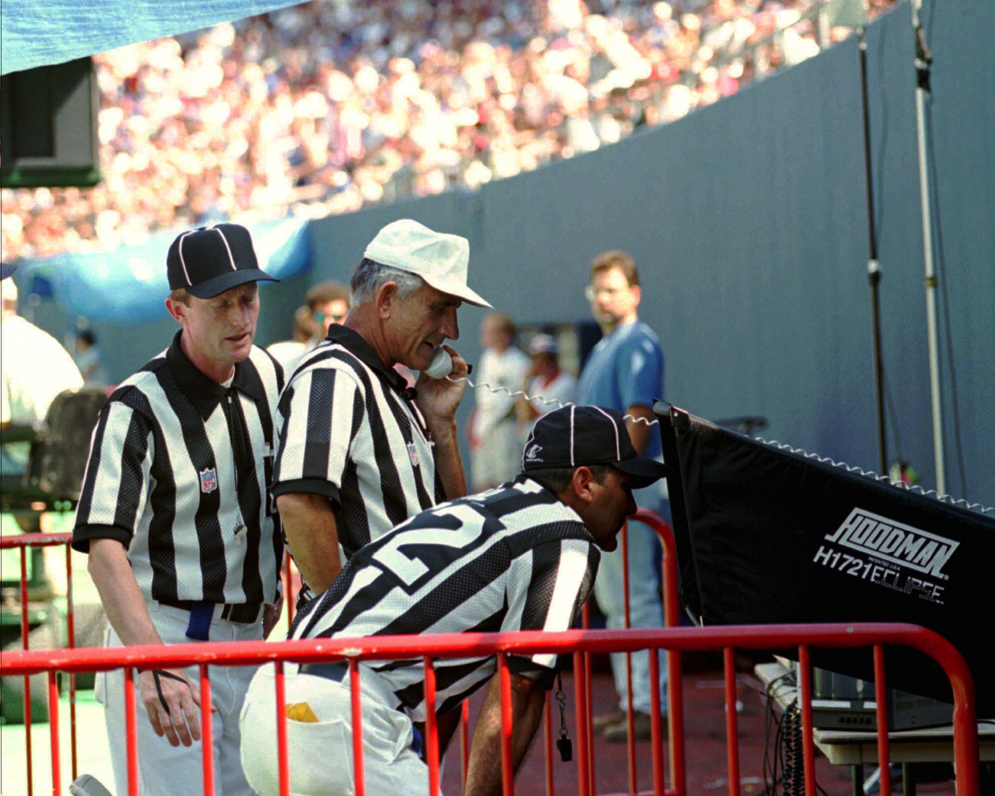
Referee Bob McElwee reviews a play with an on-field monitor during the 1996 preseason testing of the new system. (AP Photograph/Beak Kostroun)
A new arrangement was approved for testing in 10 preseason games in 1996. Coaches could challenge rulings on the field and replay at present covered iii categories of plays: out of bounds, number of players on the field and scoring plays.
Each omnibus could claiming three plays per half — at the cost of a timeout per review. The league went away from the onetime version of replay officials in skyboxes and gave referees the authority to review plays on the field inside a berth equipped with monitors. And referees at present had merely 90 seconds to brand their ruling.
Despite the changes, owners voted against implementation for the 1997 regular season. The main hang-upwardly centered on each review costing teams a timeout, fifty-fifty when a challenge was successful.
Heading into the 1999 season, the Competition Commission again adjusted its proposal to address owners' and coaches' concerns. Voters responded, overwhelmingly approving the new system 28-3. Instant replay review was back in the NFL.
The new system addressed some of the primary criticisms of past versions.
- To minimize delays, the league cut the number of challenges from iii to 2 per half.
- Coaches, unwilling to trade a timeout for any review, would now be charged a timeout only for unsuccessful challenges.
- And and then coaches could focus at the end of each one-half on which plays to telephone call and non which calls to claiming — a replay banana initiated all reviews inside the terminal two minutes of each one-half.
"I guess [the voters] felt this was a compromise," Tampa Bay Buccaneers coach Tony Dungy said, "that it won't ho-hum the game downward as well much while information technology however lets coaches coach during the concluding 2 minutes of both halves."
Ever IMPROVING
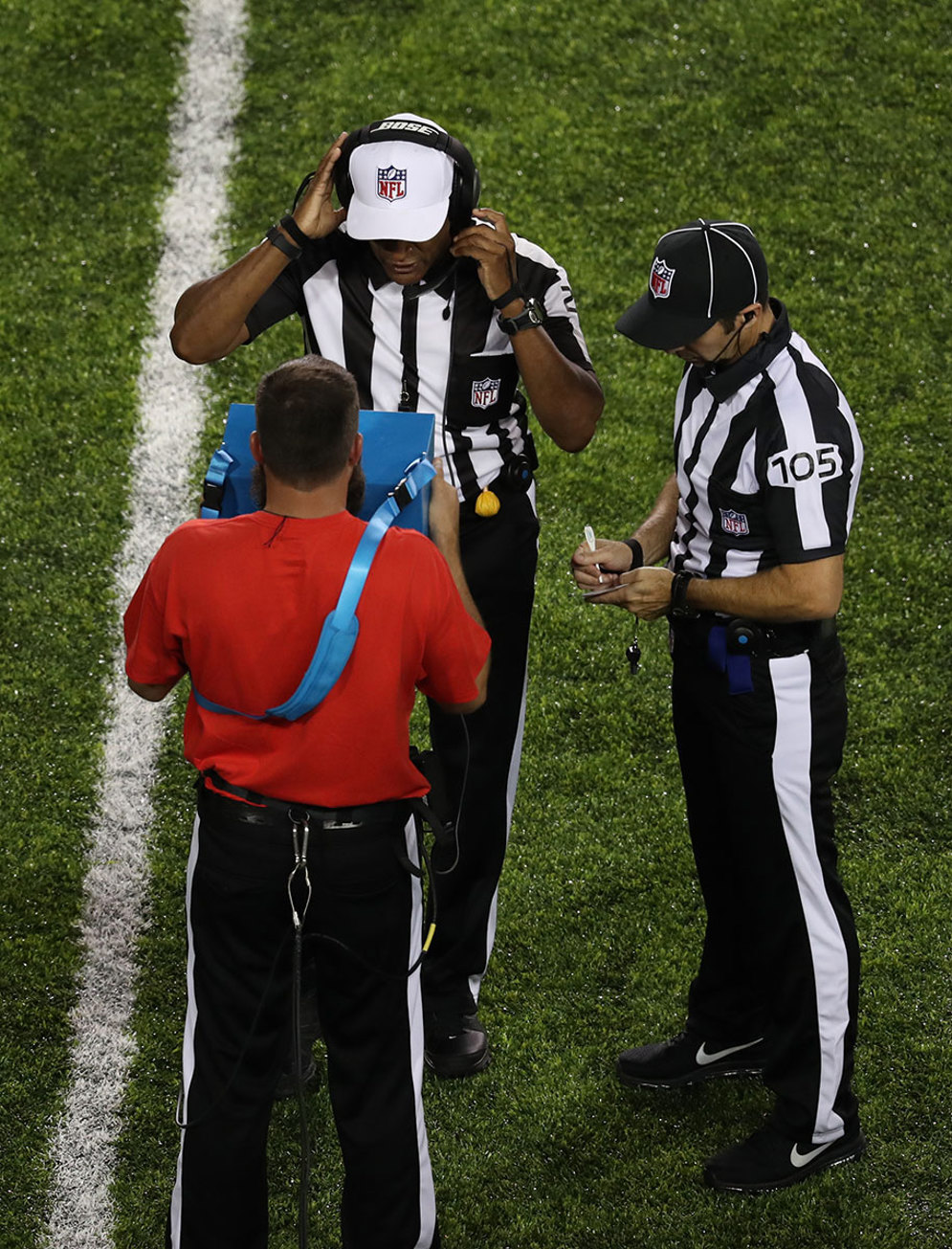
Starting time in 2017, referees volition view replays on wired, mitt-held Microsoft Surface tablets.
Since its render, the league has taken steps to meliorate the process and limit errors every bit much as possible — and engineering science continues to catch up with the ambitious task of replay review.
Long gone were the VCRs and pocket-size monitors. Referees now viewed multiple angles at i time using 3 touch-screen monitors under the hood. Mike Holmgren, co-chairman of the Competition Commission, said: "Nosotros'll get the all-time technology available."
Tweaks to replay review continued throughout the decade. In 2004, a reward was added for coaches who were successful on their get-go 2 reviews: a 3rd challenge. That same twelvemonth, owners extended the replay arrangement for the next five seasons — with the hopes of permanently approval the tool in the virtually future.
"Hopefully, the next time nosotros put it upwards for a vote we tin make information technology permanent," Baltimore Ravens general managing director and Competition Committee member Ozzie Newsome said later the five-year extension.
Newsome'southward wish came true just a few years later. A 2007 decision put an end to what had become a yearly argue. With a 30-2 owner'due south vote, instant replay became a permanent fixture in the league.
"It'southward a long time coming. Instant replay is an accustomed part of the game," said Atlanta Falcons general manager and Competition Committee Co-Chairman Rich McKay.
The NFL fabricated the switch to high-definition review systems in 2007 — the first of its kind in major American sports. Officials now could review images five times sharper than the previous iteration and freeze images for a closer await. The improved systems were installed in every stadium for $300,000 per squad.
"This is a rare opportunity to leverage cutting-border technology to ameliorate the integrity of the game. Our referees will now be able to see images much more clearly, giving reviews in critical situations the level of scrutiny they truly deserve," said Mike Pereira, NFL's vice president of officiating from 2001 to 2009.
A Modern Do
In the 2014 season, senior officiating staff members within Art McNally GameDay Central (AMGC) in the league's New York headquarters began consulting directly with the referee during reviews. The motility helped ensure that calls are existence made consistently across the league.
The review process started in New York. As the referee gathered details about the challenge, replay officials in the stadium and in AMGC compiled the all-time available angles from the circulate feed. Past the time the referee arrived at the booth, the best replays were queued up and prepare for review. The modify to a consultation model was aimed at reducing the review's impact on the length of the game.
While the consultation model largely remains in identify today, the Competition Committee voted to make two additional changes earlier the 2017 flavour. Final decisions on all replay reviews would come up from designated senior members of the officiating department in AMGC and referees view all replay video on wired, mitt-held Microsoft Surface tablets.
| Year | Games | Total Plays Reviewed | Avg. Reviews/ Game | Total Plays Reversed | Percentage of plays reversed | Avg. Delay/ Review |
| 1999 | 248 | 195 | 0.viii | 57 | 29% | ii:54 |
| 2000 | 248 | 247 | 1.0 | 84 | 34% | iii:05 |
| 2001 | 248 | 258 | 1.0 | 89 | 34% | 3:04 |
| 2002 | 256 | 294 | 1.ane | 94 | 32% | iii:01 |
| 2003 | 256 | 255 | one.0 | 66 | 26% | 3:13 |
| 2004 | 256 | 283 | 1.1 | 88 | 31% | 3:18 |
| 2005 | 256 | 295 | one.two | 92 | 31% | iii:16 |
| 2006 | 256 | 311 | 1.ii | 107 | 34% | 2:37 |
| 2007 | 256 | 327 | 1.3 | 122 | 37% | 2:38 |
| 2008 | 256 | 315 | 1.2 | 117 | 37% | 2:twoscore |
| 2009 | 256 | 328 | i.3 | 126 | 38% | two:39 |
| 2010 | 256 | 361 | 1.four | 133 | 37% | 2:42 |
| 2011 | 256 | 390 | 1.5 | 172 | 44% | ii:30 |
| 2012 | 256 | 435 | ane.7 | 170 | 39% | two:33 |
| 2013 | 256 | 423 | 1.vii | 185 | 44% | ii:25 |
| 2014 | 256 | 439 | 1.7 | 151 | 34% | 2:xiii |
| 2015 | 256 | 415 | 1.vi | 176 | 42% | 2:xvi |
| 2016 | 256 | 345 | 1.4 | 149 | 43% | 2:25 |
| 2017 | 256 | 429 | 1.vii | 196 | 46% | one:44 |
| 2018 | 256 | 349 | one.iv | 172 | 49% | 2:01 |
| 2019 | 256 | 417 | 1.6 | 196 | 47% | 2:08 |
| 2020 | 256 | 364 | 1.4 | 198 | 54% | ii:26 |
| 2021 | 272 | 279 | one.3 | 158 | 57% | 2:23 |
| 1999- 2021 | 5,880 | 7,754 | 1.32 | 3,098 | 40% | 2:37 |
Chicago Bears president Ted Phillips said after the successful 1999 vote, "We don't know if information technology's the perfect organization."
The perfect system? The NFL may never findthe perfect system. But each year, instant replay improves dramatically. Technology has helped the league come up a long way — from stopwatches, walkie-talkies and pagers. And engineering science will continue to better the process, allowing the league to make rulings correctly and consistently.
Source: https://operations.nfl.com/officiating/instant-replay/history-of-instant-replay/